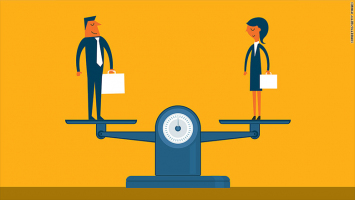Equal Pay for Equal Work: Enough Said
The views expressed are those of the author and do not necessarily reflect the views of ASPA as an organization.
By Tosha Wilson-Davis
May 18, 2018

Photo Courtesy of CNN Money
No Change Since 1869
“Equal Pay for Equal Work!” Why is this such a difficult concept to grasp when it’s straight forward and just the right thing to do? Gender inequality has been an issue in employment for centuries and dates back to 1869, according to Time Magazine. In an article found at Time.com, it was noted that in February 1869, a letter to the editor of the New York Times questioned pay inequality. “Very few persons deny the justice of the principle that equal work should command equal pay without regard to the sex of the laborer,” the author wrote. “But it is one thing to acknowledge the right of a principle and quite another to practice it.” The author also went on to assert that the U.S. Government employed 500 women in the Treasury department, but that their pay was only half of the pay of their male counterparts. With such a bold and eloquent statement in 1869 and considering the massive economic and social growth we have experienced here in the United Stated, it is quite astonishing that women are still fighting their way up on the corporate and pay ladder.
Where We Stand Today
A 2016 study by the American Association of University Women (AAUW) indicated that women working full time in the United States typically were paid just 80 percent of what men were paid, which constitutes a gap of 20 percent. In other words, for every $1 earned by men, women earned $0.80. How is this fair? It is not fair. It is interesting to note that women are receiving higher education at alarming rates. The domestic, stay-at-home persona is fading. According to CNBC, “Millennial women are so outpacing men in higher education that it’s inevitable they will become their generation’s top earners.” Such a statement suggests women may be closing in on the gender pay gap. With the increase in education, logically an increase in wealth will follow. However, this is not what studies are showing. Even now, the pay gap remains at 20 percent. So, where do we go from here to decrease this percentage?
Taking a Stand – Now NOT Later
With the turtle-like process we have witnessed thus far in closing the pay gap, it is time for all to step up and take a stand to ensure pay is equal for all. It is worth every penny! Legislators, government leaders, employees and business CEOs must take the necessary action to review why this gap still exists and what meaningful and measurable steps to take to implement change. Oftentimes, many policymakers fail to perform the final step of the policymaking process which is policy evaluation. This final step is crucial as it allows policymakers to review current policy and evaluate effectiveness or the lack of. Becoming overly committed to existing policies and programs can pose great harm and impede the capacity to learn from experience and to improve government performance. In this case, it has been a disservice to women.
Big Names Getting Involved
Cross your legs and just sit quietly. Yes, this may have been a statement that many women were used to hearing some decades ago, but today, such a statement is simply gone with the wind and “just ain’t fittin” as Hattie McDaniel/Mammy would say. Women are making their opinions and assertions known by speaking up and out about such unfair practices in the workplace. They are doing so in high profile venues such as the Oscars. Many famous women in Hollywood have used their status and the spotlight to advocate for pay equity, from Patricia Arquette to Meryl Streep to Frances McDormand, the message is simple: Women matter!
Also, men are getting in on the action. Former President, Barack Obama voiced his thoughts on pay inequality during a 2015 Town Hall in North Carolina stating, “Let me tell you, now, Michelle would point out First Ladies get paid nothing,” the president said to laughter. “So, there’s clearly not equal pay in the White House when it comes to her and me.”
Bottom Line
In the last few years, the fight to end pay inequality has permeated social and economic mediums throughout the nation and will continue to resonate until women are paid equally and recognized for their worth. Fairness above all should be the top priority and those in the driver’s seat must be willing to steer change so that women receive equal pay for equal work. It’s a simple concept. Stepping up to implement policies that promote fair and equal pay will not only be powerful but also priceless.
Author: Tosha Wilson-Davis, MPA, MSCJ, Justice Studies Department Chair/Assistant Professor of Criminal Justice, Georgia Military College [email protected]




 (10 votes, average: 4.20 out of 5)
(10 votes, average: 4.20 out of 5)
 Loading...
Loading...
Equal Pay for Equal Work: Enough Said
The views expressed are those of the author and do not necessarily reflect the views of ASPA as an organization.
By Tosha Wilson-Davis
May 18, 2018
Photo Courtesy of CNN Money
No Change Since 1869
“Equal Pay for Equal Work!” Why is this such a difficult concept to grasp when it’s straight forward and just the right thing to do? Gender inequality has been an issue in employment for centuries and dates back to 1869, according to Time Magazine. In an article found at Time.com, it was noted that in February 1869, a letter to the editor of the New York Times questioned pay inequality. “Very few persons deny the justice of the principle that equal work should command equal pay without regard to the sex of the laborer,” the author wrote. “But it is one thing to acknowledge the right of a principle and quite another to practice it.” The author also went on to assert that the U.S. Government employed 500 women in the Treasury department, but that their pay was only half of the pay of their male counterparts. With such a bold and eloquent statement in 1869 and considering the massive economic and social growth we have experienced here in the United Stated, it is quite astonishing that women are still fighting their way up on the corporate and pay ladder.
Where We Stand Today
A 2016 study by the American Association of University Women (AAUW) indicated that women working full time in the United States typically were paid just 80 percent of what men were paid, which constitutes a gap of 20 percent. In other words, for every $1 earned by men, women earned $0.80. How is this fair? It is not fair. It is interesting to note that women are receiving higher education at alarming rates. The domestic, stay-at-home persona is fading. According to CNBC, “Millennial women are so outpacing men in higher education that it’s inevitable they will become their generation’s top earners.” Such a statement suggests women may be closing in on the gender pay gap. With the increase in education, logically an increase in wealth will follow. However, this is not what studies are showing. Even now, the pay gap remains at 20 percent. So, where do we go from here to decrease this percentage?
Taking a Stand – Now NOT Later
With the turtle-like process we have witnessed thus far in closing the pay gap, it is time for all to step up and take a stand to ensure pay is equal for all. It is worth every penny! Legislators, government leaders, employees and business CEOs must take the necessary action to review why this gap still exists and what meaningful and measurable steps to take to implement change. Oftentimes, many policymakers fail to perform the final step of the policymaking process which is policy evaluation. This final step is crucial as it allows policymakers to review current policy and evaluate effectiveness or the lack of. Becoming overly committed to existing policies and programs can pose great harm and impede the capacity to learn from experience and to improve government performance. In this case, it has been a disservice to women.
Big Names Getting Involved
Cross your legs and just sit quietly. Yes, this may have been a statement that many women were used to hearing some decades ago, but today, such a statement is simply gone with the wind and “just ain’t fittin” as Hattie McDaniel/Mammy would say. Women are making their opinions and assertions known by speaking up and out about such unfair practices in the workplace. They are doing so in high profile venues such as the Oscars. Many famous women in Hollywood have used their status and the spotlight to advocate for pay equity, from Patricia Arquette to Meryl Streep to Frances McDormand, the message is simple: Women matter!
Also, men are getting in on the action. Former President, Barack Obama voiced his thoughts on pay inequality during a 2015 Town Hall in North Carolina stating, “Let me tell you, now, Michelle would point out First Ladies get paid nothing,” the president said to laughter. “So, there’s clearly not equal pay in the White House when it comes to her and me.”
Bottom Line
In the last few years, the fight to end pay inequality has permeated social and economic mediums throughout the nation and will continue to resonate until women are paid equally and recognized for their worth. Fairness above all should be the top priority and those in the driver’s seat must be willing to steer change so that women receive equal pay for equal work. It’s a simple concept. Stepping up to implement policies that promote fair and equal pay will not only be powerful but also priceless.
Author: Tosha Wilson-Davis, MPA, MSCJ, Justice Studies Department Chair/Assistant Professor of Criminal Justice, Georgia Military College [email protected]
Follow Us!